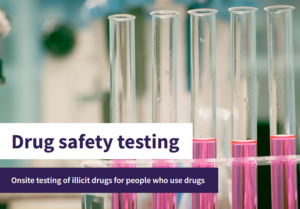Aotearoa, the Māori name for New Zealand, has become the first country in the world to put drug safety testing services on a solid legal footing. Read about the unique opportunity this provides for implementing drug safety testing services, and browse the latest resources on the SSA website to see how Aotearoa compares to the UK.
Drug safety testing (also known as drug checking) involves analysing illicit drugs to identify what they contain. The aim, generally, is to reduce the harms associated with drug use, for example by informing people who intend to use them how strong the drugs are, and whether there are any unexpected ingredients. Some drug safety testing interventions, however, prioritise other aims over harm reduction, such as gathering intelligence about the illicit drug market or promoting treatment for substance use problems.
A ‘permanent licensing system’
On 23 November, New Zealand / Aotearoa’s Drug and Substance Checking Legislation Bill was passed into law, making the Drug and Substance Checking Legislation Act 2021 the first piece of legislation to provide permanent legal protection for drug safety testing services. The Act will come into force on 7 December, and the government has pledged $800,000 to support “the coordination of the services nationally, including training drug checkers for large festivals and events”.
The Act makes amendments to earlier pieces of legislation, such as the Misuse of Drugs Act 1975, Misuse of Drugs Regulations 1977, Medicines Act 1981, and Psychoactive Substances Act 2013 in order to remove barriers to delivering drug safety testing services.
The Act also puts in place a “permanent licensing system”, through which organisations can apply to the Director-General of Health for a licence to be a “drug and substance checking service provider”.
In deciding whether to grant a license, the Director-General of Health must be satisfied that the organisation provides “accurate and appropriate harm reduction advice with test results”, which means that:
- the information or advice should be based on the best information available at the time to the service provider
- the information or advice should not consist solely of advice against consuming a drug or substance
- the information or advice should not be stigmatising, nor should it express a moral judgement about people who use drugs
- the information or advice should be tailored for the person who is receiving it and their circumstances
The new legislation does not stipulate which methods of forensic analysis service providers should use. However, it does say that the Director-General of Health will assess whether “the applicant’s proposed service model (including the proposed methods for testing drugs and substances) will enable the applicant to carry out their functions as a service provider to an appropriate standard”.
At present (December 2021), only four providers are approved to deliver drug safety testing services in Aotearoa. The new licensing system should make it possible for more providers to come forward, and furthermore, for people who use drug safety testing services to be reassured that those operating prioritise harm reduction.
Contrasting Aotearoa with the UK
A single UK provider was granted a licence by the Home Office in 2019 to pilot a limited ‘drug checking’ intervention, which involved screening a comparatively small sample of drugs, and using a method of analysis that could not provide much detail about the contents of those drugs. The intervention in this case was intended to be a route into treatment for substance use problems, more so than a way of facilitating harm reduction.
All other drug safety testing interventions in the UK are delivered with the agreement of local stakeholders, but without the specific legal protections offered in Aotearoa, or the potential restrictions of a licence granted by a government that may not fully support the goal of harm reduction.
The outcomes of drug safety testing can vary from intervention to intervention, but potentially extend from the individual level (e.g. people choosing to dispose of their drugs after hearing the results), to the community level (e.g. fewer adverse events relating to a dangerous substance on the market), and societal level (e.g. reduction in population overdose rates and drug-related deaths).
While it remains difficult to demonstrate that drug safety testing can have an impact on the broader outcome of drug-related deaths, Deputy Coroner Harriet Grahame, who led an inquest into six festival patron deaths in New South Wales (Australia), found that: “There is evidence of behavioural change, with the potential to reduce harm or death.”
In the UK, evidence of positive behavioural changes associated with drug safety testing includes:
- people choosing to dispose of their drugs after hearing the results
- people taking a smaller dose than they had planned
- people warning friends about potentially dangerous drugs

Click on the image (above) to read a new resource on the SSA website summarising what drug safety testing is, how it is delivered, and whether it is effective
An ‘emerging evidence base’
The SSA website is gathering information about drug safety testing and its emerging evidence base. Key links include:
- a new resource summarising what drug safety testing is, how it is delivered, and whether it is effective
- an ‘evidence spotlight’ by Rob Calder and Natalie Davies, who reviewed the literature to see what can be learned about the effectiveness of drug safety testing, and what circumstances are necessary for it to reach its full potential
- an interview with Dr. Amira Guirguis about the scope of the first Home Office-licensed drug checking intervention, set inside a community substance misuse service in Somerset
The opinions expressed in this post reflect the views of the author(s) and do not necessarily represent the opinions or official positions of the SSA.
The SSA does not endorse or guarantee the accuracy of the information in external sources or links and accepts no responsibility or liability for any consequences arising from the use of such information.

